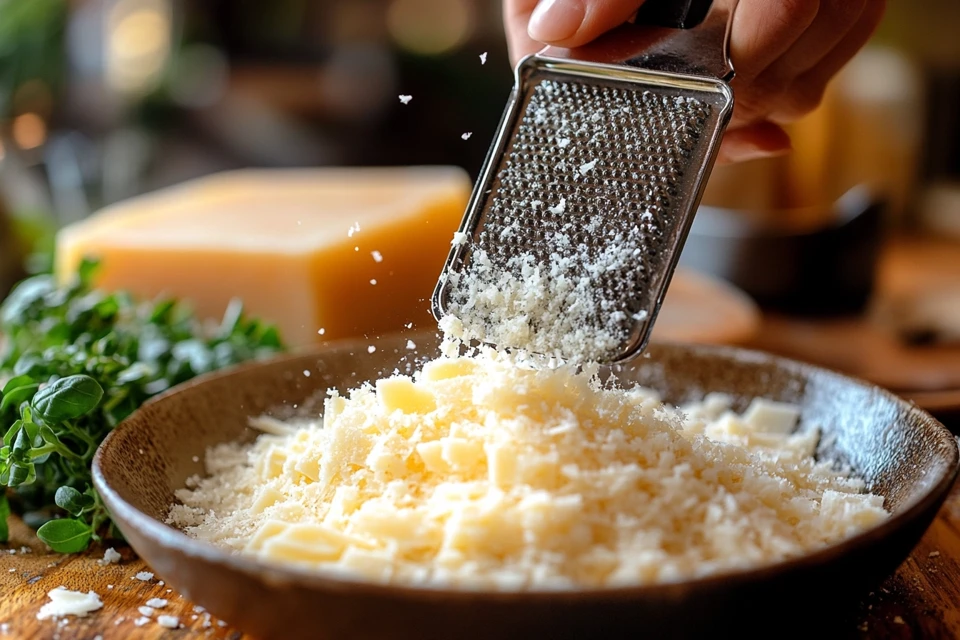When you think of cheese, chances are the first thing that pops into your mind is a big, delicious block or perhaps a pile of grated cheese ready to sprinkle on your pizza. But what if I told you that there’s a whole world of flavor and cooking magic waiting for you in a Cheese Parmesan Wheel? Yes, you heard that right! The parmesan wheel is one of the most fun, versatile, and flavorful ingredients you can have in your kitchen.
In this guide, we’re going to take a deep dive into everything you need to know about the cheese parmesan wheel—from its origins to how to use it in your dishes. We’ll also cover some common problems that may arise when dealing with parmesan and offer some simple solutions to keep your parmesan experience as smooth as possible. Ready to get started? Let’s go!
Table of Contents
What is a Cheese Parmesan Wheel?
Let’s start with the basics. A Cheese Parmesan Wheel is exactly what it sounds like: a large, round wheel of parmesan cheese that’s typically about 30–40 pounds in weight. It’s a block of pure, unadulterated parmesan cheese, aged to perfection. The shape of the wheel allows the cheese to mature evenly, giving it that distinct rich, nutty, and tangy flavor we all know and love.
But why go for a wheel of parmesan instead of the pre-grated stuff you find in the store? Well, when you buy parmesan in a wheel, you’re getting fresh cheese at its peak flavor. The difference between freshly grated parmesan from the wheel and the powdered, pre-packaged version is like the difference between a fresh apple picked right off the tree and a canned one that’s been sitting on a shelf for months. Simply put: fresh is better!
The Origin of Parmesan Cheese
So, where did parmesan cheese come from, and why is it so special? Parmesan, or Parmigiano-Reggiano as it’s officially called, originates from Italy, specifically from the regions of Parma, Reggio Emilia, Modena, and others in the north of Italy. This cheese has been made the same way for over 800 years! It’s so well-regulated that only cheese made in these specific areas can legally be called Parmigiano-Reggiano. Imagine how proud those cheesemakers must be!
Parmigiano-Reggiano has a rich history, tied to the traditions and culture of the Italian countryside. It’s made using a blend of cow’s milk, rennet, and salt, and the aging process can range from 12 months to even 36 months, depending on the desired flavor and texture. The longer it ages, the crumblier and more intense the flavor becomes.
How Parmesan Cheese is Made
The process of making parmesan cheese is a true art form. First, the cow’s milk is collected from local farms and combined with natural whey starter cultures. This mixture is then heated to a specific temperature, causing the milk to coagulate into curds and whey. The curds are then cut, cooked, and pressed to remove excess moisture. The cheese is placed into a mold, and it’s left to age in cool, humid cellars, where it develops its signature texture and flavor over time.
Fun Fact: The word “parmesan” comes from the name of the region where this cheese was first made—Parma, Italy. But the authentic version can only come from the areas approved by the European Union, making it a truly special and protected product!
Why Choose a Cheese Parmesan Wheel?
Now, you might be thinking, “Why should I bother buying a parmesan wheel when I can just pick up a small block of cheese at the grocery store?” Well, let me tell you, the benefits of choosing a parmesan wheel are many! Not only do you get fresh, flavorful cheese that can be grated on the spot, but you also get an experience that makes cooking more fun and adventurous.
The Advantages of Using a Parmesan Wheel in Cooking
Using a parmesan wheel comes with a whole host of benefits. For one, the cheese is fresher, and fresh cheese means more flavor. When you grate parmesan directly from the wheel, you’re releasing the full aroma and flavor of the cheese into your dish. Plus, since you’re grating it yourself, you can control the texture, whether you want a fine dusting or a more chunky grate.
Another major perk of a parmesan wheel is the versatility it offers. Need some parmesan for pasta, pizza, or a salad? No problem! Need it for a gourmet risotto or a savory soup? You’ve got it! The parmesan wheel is perfect for any occasion, whether you’re preparing an everyday meal or a fancy dinner party. The possibilities are endless!
How Fresh Parmesan Enhances Your Dishes
Imagine this: a creamy bowl of pasta with a generous sprinkle of fresh, grated parmesan on top. The rich, savory flavor of the cheese takes the dish to a whole new level, making it something special. Fresh parmesan brings out the depth of flavor in any dish, whether it’s mixed into sauces, melted over vegetables, or sprinkled on top of a fresh salad. And let’s not forget about how parmesan pairs so well with things like balsamic vinegar, truffle oil, and olive oil, giving your meals that extra kick of deliciousness.
The flavor of fresh parmesan is complex and layered—nutty, tangy, salty, and a little sweet, all at once. When you use a parmesan wheel, you’re unlocking a treasure trove of these incredible flavors in your dishes. It’s like adding a little magic to your food.
How to Use a Cheese Parmesan Wheel in Your Kitchen
Now that you’re convinced that a cheese parmesan wheel is a must-have in your kitchen, let’s talk about how to make the most of it. From storing it properly to cutting and serving it like a pro, we’ve got you covered.
Tips for Storing a Parmesan Wheel Properly
Proper storage is key to ensuring your parmesan wheel stays fresh for as long as possible. If you’re using it right away, simply cover the exposed area with plastic wrap to keep it from drying out. For longer storage, the best way to preserve your parmesan wheel is to keep it in a cool, dry place—ideally in a wine cellar or a dedicated cheese fridge.
Once you’ve cut into the wheel, make sure to wrap the remaining piece tightly in plastic wrap or wax paper. Some people even store it in a sealed container to prevent the cheese from absorbing odors from other foods. Also, remember that the longer you keep it, the harder it will become. But don’t worry, aged parmesan is still delicious in different dishes, especially when shaved or crumbled!
How to Cut and Serve Parmesan Cheese from the Wheel
Cutting a parmesan wheel might sound intimidating, but don’t worry—it’s actually pretty easy if you have the right tools. You’ll need a sturdy cheese knife or a parmesan knife (which is designed for the job) and a little elbow grease. Simply score the wheel and begin cutting along the natural cracks. If the wheel is too large to handle on your own, consider using a cheese wire to make even slices.
For serving, freshly grated parmesan is best. Use a microplane grater or a box grater to release that heavenly aroma and add it to your dishes as you please. Want to impress your guests at a dinner party? Serve the parmesan wheel at the table with a small grater so everyone can grate their own cheese. It’s interactive, fun, and delicious!

Ideal Tools for Cutting Parmesan from a Wheel
When you’re ready to tackle the parmesan wheel, having the right tools is crucial. A good-quality cheese knife is essential, as it’ll allow you to cut through the hard cheese without damaging it. Additionally, a cheese wire can help you make even slices without putting too much pressure on the wheel. For grating, you can’t go wrong with a microplane, which will give you light, fluffy parmesan that melts beautifully over pasta or salad.
Delicious Recipes Featuring Parmesan Cheese Wheel
Now that you know all about the cheese parmesan wheel and how to use it, let’s get into the fun part: the recipes! Whether you’re preparing a simple meal for yourself or a grand feast for guests, parmesan can take any dish to the next level. And when you’re working with fresh parmesan from the wheel, you’re in for a treat. Here are some delicious ideas to make the most of your parmesan cheese wheel.
Pasta Recipes with Freshly Grated Parmesan
There’s something about pasta and parmesan that just belongs together. If you want to create a perfect plate of pasta, fresh parmesan is a must. From spaghetti to fettuccine, parmesan adds depth, creaminess, and a savory kick that elevates any sauce. Try this simple yet stunning parmesan spaghetti:
Ingredients:
– 1 pound spaghetti
– 1 cup freshly grated parmesan
– 1/2 cup olive oil
– 2 cloves garlic, minced
– Salt and pepper to taste
– Fresh parsley for garnish
Instructions:
1. Cook the spaghetti according to the package instructions.
2. In a large pan, heat olive oil and sauté garlic until fragrant.
3. Add the cooked spaghetti to the pan, tossing with olive oil and garlic.
4. Stir in freshly grated parmesan, adding more to taste.
5. Garnish with fresh parsley and serve immediately.
This is a super easy recipe that can be made in 15 minutes and is perfect for weeknight dinners. The key here is using fresh parmesan—it makes all the difference!
Parmesan-Crusted Chicken: A Perfect Dish for Any Meal
If you’ve ever had chicken with a crispy, golden parmesan crust, you know just how irresistible it can be. And when you use a parmesan wheel to make the crust, it’s even better. Here’s a simple recipe for parmesan-crusted chicken:
Ingredients:
– 4 boneless, skinless chicken breasts
– 1 cup freshly grated parmesan
– 1 cup panko breadcrumbs
– 2 eggs, beaten
– 1/2 cup flour
– Salt and pepper to taste
– Olive oil for frying
Instructions:
1. Season chicken breasts with salt and pepper.
2. Dredge the chicken in flour, dip in beaten eggs, and then coat in the parmesan and panko mixture.
3. Heat olive oil in a large pan over medium heat and cook chicken until golden and crispy, about 4-5 minutes per side.
4. Serve with a side of roasted vegetables or a simple salad.
This crispy parmesan chicken is perfect for a dinner party or a quick weeknight meal. The parmesan crust gives the chicken a crunchy, flavorful exterior that’s absolutely mouthwatering!

Creative Ways to Add Parmesan to Your Appetizers
Parmesan isn’t just for main courses—it can shine in appetizers too! One of my favorite ways to use parmesan is by making parmesan crisps that can be used as a snack or a garnish. Here’s how you can make them:
Ingredients:
– 1 cup freshly grated parmesan
– 1/4 teaspoon black pepper
– 1/4 teaspoon garlic powder
– Fresh herbs for garnish (optional)
Instructions:
1. Preheat your oven to 400°F (200°C) and line a baking sheet with parchment paper.
2. Place small mounds of parmesan on the baking sheet, flattening them slightly.
3. Sprinkle with pepper and garlic powder.
4. Bake for 5-7 minutes, or until the crisps are golden and crispy.
5. Garnish with fresh herbs if desired and serve immediately.
These crispy little bites are perfect for serving at parties or as a side to your favorite dip. They’re super easy to make and packed with parmesan goodness!
Common Problems with Parmesan Cheese Wheels and How to Solve Them
As with any ingredient, working with a parmesan wheel can come with its challenges. But don’t worry, I’ve got your back! Here are some of the most common problems you might face when using a parmesan wheel—and simple solutions to fix them.
Why is Parmesan Sometimes Too Hard to Grate?
If your parmesan is too hard to grate, it’s likely because it’s been aged for a longer period. Aged parmesan tends to be firmer and crumblier, which can make it a bit tricky to grate. But don’t let that discourage you! The solution is simple: try warming it slightly before grating. Just take the parmesan out of the fridge and let it sit at room temperature for about 15 minutes. This should make it easier to grate without breaking your grater. You can also use a fine grater for a finer texture if you prefer it that way.
How to Deal with Cracking or Dry Parmesan
If you find that your parmesan is starting to crack or dry out, it may be a sign that it’s been exposed to air for too long. This is easy to fix: just wrap your parmesan tightly in wax paper or plastic wrap and store it properly in a cool place. You can also use a damp paper towel around the cheese to keep it moist. If it’s already too dry, grate it finely and use it as a topping for soups or casseroles, where the moisture can help bring it back to life.
How to Prevent Parmesan from Spoiling Too Quickly
Parmesan can last for quite a while if stored correctly, but it does need some attention. To prevent it from spoiling too quickly, always make sure to store your parmesan in a sealed container or wrap it tightly in plastic wrap. If you’re working with a parmesan wheel, keep the exposed part covered to prevent air from getting in. The wheel should ideally be kept in a cool, dry place, like a cellar or fridge, to maintain its flavor and texture for longer.
Nutritional Benefits of Parmesan Cheese
Not only is parmesan cheese delicious, but it also offers a host of nutritional benefits. Here’s why you can feel good about indulging in some freshly grated parmesan:
High Protein, Low Carbs: What Makes Parmesan a Healthy Choice
Parmesan cheese is a great source of protein, with about 10 grams of protein per ounce. It’s also low in carbohydrates, making it an excellent choice for anyone following a low-carb or ketogenic diet. So go ahead, sprinkle as much parmesan as you like—it’s not only tasty but also good for you!
Parmesan and Calcium: Why It’s Good for Your Bones
Parmesan is also packed with calcium, which is crucial for strong, healthy bones. Just one ounce of parmesan contains about 30% of your daily recommended calcium intake. So, if you’re looking to boost your bone health, a little parmesan can go a long way.
Where to Buy the Best Cheese Parmesan Wheels
When you’re ready to purchase a parmesan wheel, there are a few places you can check out. Gourmet grocery stores, specialty cheese shops, and online retailers like Amazon or iGourmet are excellent sources for high-quality parmesan wheels. Be sure to look for the authentic Parmigiano-Reggiano label to guarantee that you’re getting the real deal. Don’t settle for anything less than the best!
Conclusion: Is a Cheese Parmesan Wheel Worth the Investment?
In the end, a cheese parmesan wheel is a fantastic investment for anyone who loves cooking with high-quality, fresh ingredients. The flavor, the freshness, and the versatility it offers make it an essential addition to your kitchen. Whether you’re using it for everyday meals or special occasions, parmesan from the wheel is always a winner.
So, the next time you’re in the store, consider picking up a parmesan wheel. Your taste buds (and your guests) will thank you. And trust me, once you start grating fresh parmesan from a wheel, you’ll never go back to pre-grated again. Happy cooking!

